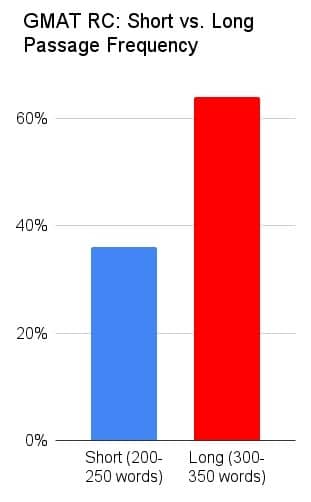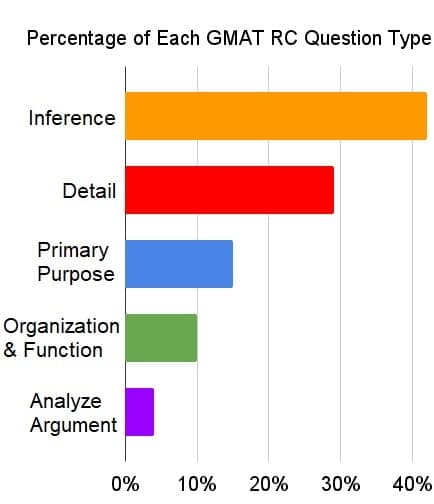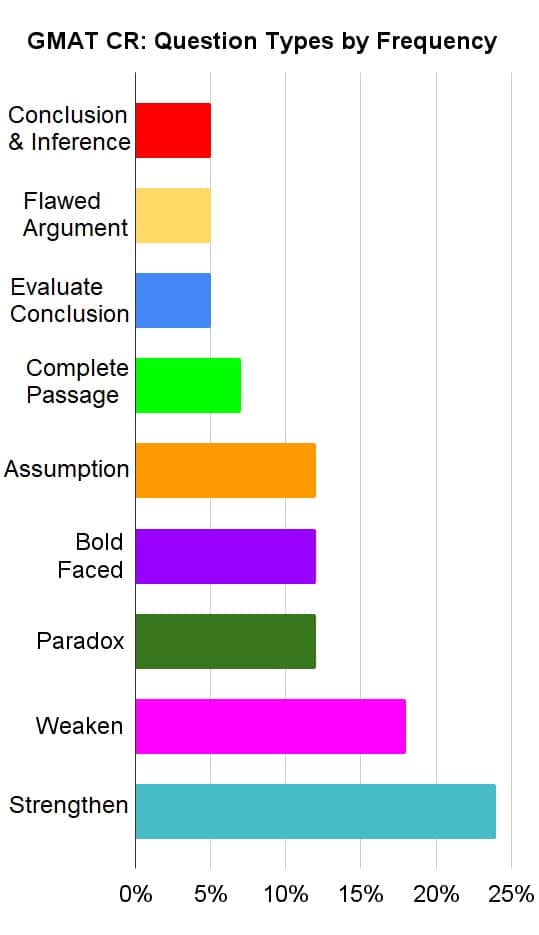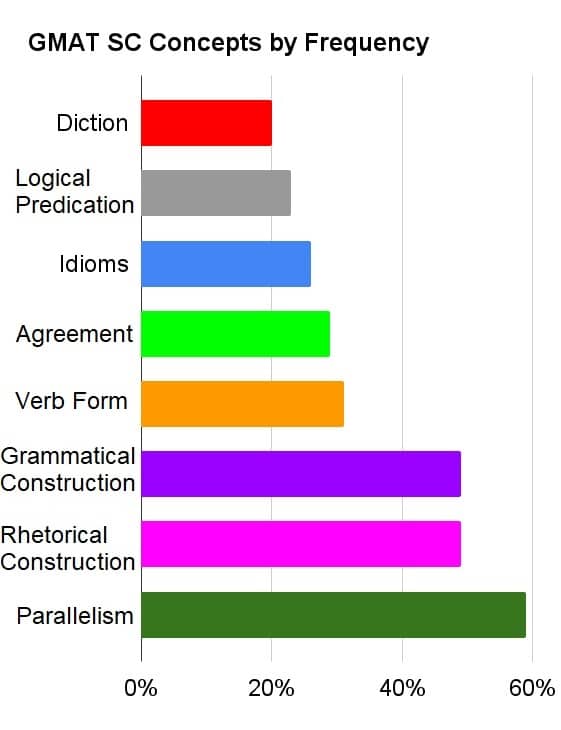
The GMAT Verbal section consists of 36 multiple-choice questions (with five answer choices each) in 65 minutes. You’ll encounter three GMAT Verbal question types: Reading Comprehension, Critical Reasoning, and Sentence Correction (though each type is divided further into subtypes). Keep reading to learn about what’s tested on GMAT Verbal and the frequency of each question type and topic!
What are the GMAT Verbal question types?
There are three broad types of questions in GMAT Verbal: Reading Comprehension questions, Critical Reasoning questions and Sentence Correction questions. Within each of these broad question types are subtypes of questions; for example, Reading Comprehension has an inference question subtype, a primary purpose question subtype, and others. Each of these three question types takes up roughly one-third of the GMAT Verbal section.
Below, we’re going to look at each of the three broad types, and their subtypes. I’ll also tell you how frequently each concept and question subtype is tested! (Frequencies come from an analysis of all Verbal questions from the last three years of GMAT Official Guides.)
Reading Comprehension
These questions start with reading a passage about social sciences, physical or biological sciences, or business/economics. Luckily, you don’t have to be an expert in these topics before taking GMAT Verbal. There are six question categories, from finding the main idea of the passage to identifying the author’s tone. To prepare for Reading Comprehension in GMAT Verbal, check out How to Study for Reading Comprehension.
GMAT Reading Comprehension Passage Topics by Frequency

| GMAT RC Passage Topic | Frequency |
|---|---|
| Science | 40% |
| Business & Economics | 36% |
| Social Science | 24% |
The Frequency of Short Passages vs. Long Ones

| RC Passage Length | Frequency on the GMAT |
|---|---|
| Short (200-250 words) | 36% |
| Long (300-350 words) | 65% |
Frequency of GMAT Reading Comprehension Question Types
While GMAT RC is one of the three main GMAT Verbal question types, there are also question types within the RC question type. Here are the five most common types of Reading Comprehension questions on the GMAT:
- Inference (identify information that is implied in the passage, but not directly stated)
- Detail (identify information that is directly stated in the passage)
- Primary Purpose (identify the main purpose the whole passage serves)
- Organization and Function (identify the purpose of a smaller part of the passage, or identify the way that the whole passage or parts of it are organized)
- Analyze the Argument (analyze the strength of an argument made in the passage)
Here is the frequency of these GMAT Verbal question types within RC:

| GMAT RC Question Type | Frequency |
|---|---|
| Inference | 42% |
| Detail | 29% |
| Primary Purpose | 15% |
| Organization and Function | 10% |
| Analyze the Argument | 4% |
A Note about EXCEPT Questions and their Frequency
Students often ask me about EXCEPT RC questions on the GMAT. These questions ask you to select the one answer that is incorrect instead of the one correct answer. Typical wording would be something like “all of the following is true EXCEPT….” It is possible for Inference, Detail, Organization & Function, or Analyze the Argument questions to have this EXCEPT pattern. But if you find this format of question difficult, I have good news: only 3% of GMAT Reading Comprehension questions fall under this category.
Critical Reasoning
Critical Reasoning questions also start with a passage, but this time you’ll be analyzing an argument—specifically, which answer choice makes the argument stronger, weaker, flawed, and more. There are eight question categories. For a detailed breakdown of this question type and the smaller question types within it (plus additional practice!), read our Introduction to Critical Reasoning article.
Frequency of the Most Common GMAT Verbal Question Types for Critical Reasoning

| GMAT Verbal CR Question Type | Frequency on the GMAT |
|---|---|
| Conclusion & Inference | 5% |
| Flawed Argument | 5% |
| Evaluate Conclusion | 5% |
| Complete the Passage | 7% |
| Assumption | 12% |
| Bold Faced | 12% |
| Paradox | 12% |
| Weaken | 18% |
| Strengthen | 24% |
Sentence Correction
Instead of a passage, you’ll see just one sentence with an underlined phrase. Your task will be to replace the underlined portion with an answer choice that makes the most sense grammatically or logically. To try this out on your own, see these top grammar tips for Sentence Correction questions.
Sentence Correction is different from RC and CR, because SC doesn’t have a list of distinctly different question subtypes. Instead, SC tests a rich variety of writing and proofreading concepts. Most SC questions test multiple concepts at the same time. Note that the percentages for SC concept frequency below add up to much more than 100%: these concepts overlap on multiple questions more often than not!
The GMAT Verbal SC Concepts and Their Frequency
- Diction (word choice)
- Logical Predication (whether or not the sentence makes clear, logical sense)
- Idioms (the structure and proper use of idiomatic phrases)
- Agreement (properly matching word forms for subject/verb and noun/pronoun)
- Verb Form (correct use of verb tense and forms)
- Grammatical Construction (correct grammar structure across longer phrases, clauses, and whole sentences
- Rhetorical Construction (use of good, clear writing style that doesn’t sound too passive, uncertain, or awkward)
- Parallelism (consistent use of the same kinds of structures and word forms in parallel parts of a sentence, such as similar clauses that touch each other, parts of a list, and so on)

| GMAT SC Concept | Frequency on the exam |
|---|---|
| Diction | 20% |
| Logical Predication | 23% |
| Idioms | 26% |
| Agreement | 29% |
| Verb Form | 31% |
| Grammatical Construction | 49% |
| Rhetorical Construction | 49% |
| Parallelism | 59% |
How long is the GMAT Verbal? What is the timing of each Verbal section?
The total time for the GMAT Verbal section is 65 minutes. With 36 GMAT Verbal questions to contend with, you’ll have between one to three minutes to complete each question, so pacing yourself is key!
Here’s what we suggest for timing for GMAT Verbal:
- For Reading Comprehension questions, allow 6 minutes for a set of 3 questions, or 8 minutes for a set of 4 questions, plus 2-4 minutes to read the passage.
- For Critical Reasoning questions, give yourself 90 seconds to 3 minutes.
- For Sentence Comprehension, aim for 60 to 90 seconds.
Like GMAT Quant, the questions are adaptive, so you might see more and more challenging ones if you’re doing well. If you’re having trouble finishing the verbal section within the time limit, check out our Ultimate Guide to GMAT Pacing.
How to prepare for the GMAT Verbal section
The max score you can achieve for the GMAT Verbal section is 800, and the average of your Verbal and Quant scores forms your overall GMAT score. With Verbal counting towards one of the more important scores that b-schools are looking at, you’ll want to be prepared for all the GMAT Verbal question types by test day.
If you’re not sure how you’d do on Verbal, you can get a baseline score by taking a diagnostic test. After taking steps to improve your score, you can re-take the diagnostic test later to measure your progress and find any remaining weak spots to focus on.
We’ve also compiled our Verbal practice questions and top tips to help you get ready!





Leave a Reply